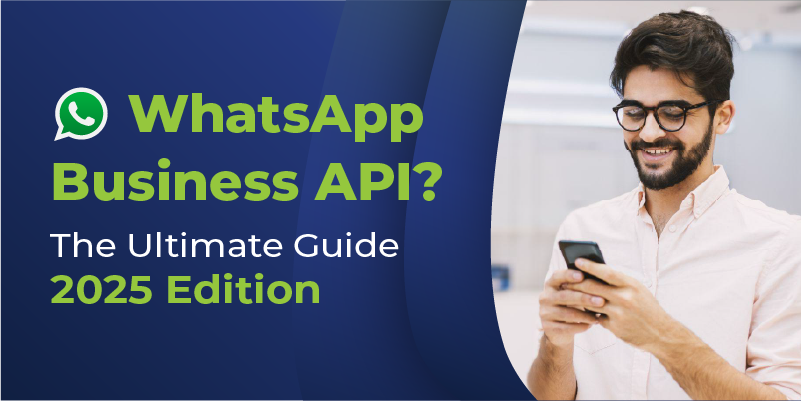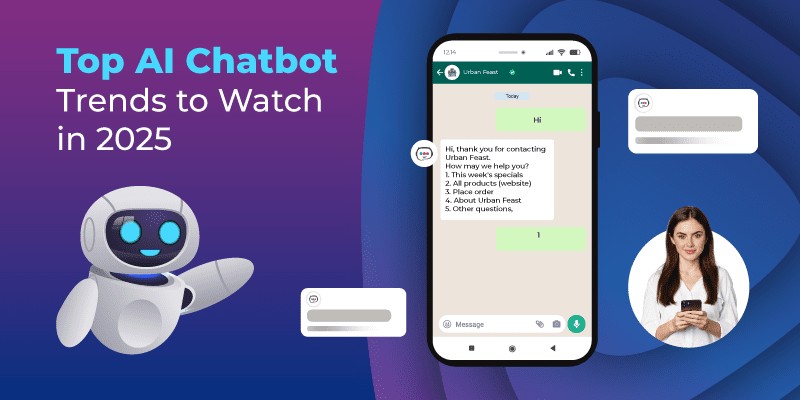Table of Contents:
Chatbots are rapidly growing, taking over almost every aspect of business management and operations. The statistics and studies are there to prove their popularity, customer preference, and emerging future trends.
Increasing demands for 24 x 7 customer service, high operational cost, high competition, and limitations of existing technology and systems fuel the chatbot revolution across sectors, areas, and industries.
By examining these statistics, we can gain insights into the usage, demographics, engagement, demand & supply, and other aspects of chatbot integration in today’s world and the future ahead.
Top Chatbot Statistics
Let’s look at these top chatbot statistics based on the following segments:
Chatbot Market Size & Growth
- The global chatbot market size will grow from $7.01 billion in 2024 to $20.81 billion in 2029.
- The market size of Conversational AI will hit $1.3 billion by 2025, growing at a CAGR of 24%.
- According to Juniper Research, the Global retail expenditure on chatbots is forecasted to reach $72 billion by 2028, growing exponentially from $12 billion back in 2023.
- AI Chatbots and live chat are the two most popular customer service channels in 2024.
- Chatbots are going to handle up to 90% of healthcare and financial inquiries by the end of this year.
- 58% of companies in the B2B sector are actively using chatbots as compared to 42% of B2C companies.
- The use of AI, including AI chatbots, is increasing in Edtech, with the global market amounting to $1.82 billion and expected to grow 36% a year by 2030.
Insights For Businesses
The global chatbot market is not just rapidly growing but is expected to continue growing over at least the next decade.
More businesses are adapting to chatbots, which calls for companies to start focusing on their chatbot integration through smart bots like Route Mobile’s Roubot.
No-code flow builder bots like Roubot allow businesses to create and customize chatbots with simple drag-and-drop features without coding knowledge. Such platforms offer companies the ability to design, test, customize, deploy, and monitor custom chatbot workflows.
AI-powered chatbots require coding expertise as they offer much more sophisticated applications using advanced machine learning (ML), natural language processing (NLP), and other AI-based components.
AI bots are ideal for businesses looking for much more complex workflows and custom interaction, whereas no-code flow builder bots are best because of their easy accessibility and quick application for faster results.
The low-code and no-code platforms (LCNC) offer a more purpose-driven or application-driven approach and are more visual in nature. Companies can start by leveraging these LCNC platforms and no-code flow builder tools and then upscale to AI chatbots for a personalized and detailed approach to achieve scalability.
Chatbot Usage & Engagement
- 68% of customers have previously used a chatbot for a customer service experience.
- 47% of users are open to buying products through a chatbot.
- 80% of consumers have interacted with chatbots at least once at some point.
- 35% of people use chatbots to resolve complaints or get detailed information.
- According to Forbes, by 2025, AI will power 95% of customer interactions.
- 36% of marketing professionals report utilizing chatbots and AI-driven customer support to engage with customers at their companies, whereas a further 20% plan to do so in the next six months.
- 90% of consumers consider an immediate response from a chatbot to be important or very important.
- 74% of consumers prefer to interact with chatbots when they want to get answers to Frequently asked questions(FAQs).
- 39% of all B2C conversations involve a chatbot.
- According to the Tidio Study, 53% of participants find that waiting Too long to get a response from businesses is the most frustrating part of interacting with them.
Insights For Businesses
Chatbots will derive most customer engagement through conversational AI, personalized targeting, and automated responses.
Further, they can be utilized across enhanced business messaging such as RCS, WhatsApp, Facebook Messenger, and others for an omnichannel approach.
Roubot, an AI-powered customer engagement tool, offers seamless integration across these mentioned channels and more. Such smart bots will be game-changers for generating quality leads and increasing revenue by leveraging the entire customer journey utilizing multiple touchpoints.
Read This: Guide To Choose A Choose a Chatbot That’s Right For Your Business
Chatbot Demographics
- According to Forbes, 60% of millennials used chatbots, and 70% reported having had a positive experience.
- 56% of GenZ participants from the study conducted by Tidio think that more companies should use chatbots.
- About 71% of GenZ use chatbots to look for products, whereas 62% prefer using chatbots for ordering food online.
- The top three countries where consumers are confident about differentiating AI bots and human customer service are the UAE (76%), Italy (75%) and India (73%).
- Only 4% of boomers will talk to a chatbot compared to 20% of Gen Z shoppers who always choose chatbots over talking to human agents.
Insights For Businesses
Numerous studies and statistics show that millennials and GenZs are more keen to use chatbots. They spend more time online, on messaging apps and social media, ordering items, food, and clothes. So, businesses have to utilize chatbots if they want to target this particular demographic, which for the most it is.
Chatbot Demand & Supply
- 86% of customers want to have an agent option for escalation when talking to a chatbot.
- 87% of consumers say their chatbot experience is either neutral or positive.
- According to Tidio, 29% of customers simply expect help 24/7 from chatbots.
- 88% of CX professionals believe that AI will enhance, not replace, the agents.
- The average chatbot satisfaction rate of customers is 62.4%
- According to a study by Tidio, 19% of online businesses already use chatbots.
- Upselling chatbots(20%), AI chatbots(19%), discount chatbots(14%), chatbots for ordering phone calls(11%) and lead generation chatbots(11%) are top five ranking at the average chatbot interaction rates for most prominent use cases.
- 17% of customers expect to be able to reach a human agent if they want to, from chatbots.
- A Tidio study states that 11% of consumers are using messages from a chatbot to ask questions in a natural way instead of searching on Google.
- 71% of customers prefer to interact with a chatbot when they want to check the status of their order.
- 59% of consumers expect a chatbot to respond to them within 5 seconds.
Insights For Businesses
Meeting customer demand is a holy grail for businesses. And when it comes to chatbots, the numbers say it all! They are more inclined to buy from a chatbot, deeming most of their user experience positive. However, they believe in the need for a human agent if there is an escalation.
Even if businesses keep tech support, customer service experts, and sales representatives, a conversational AI-powered chatbot can do the heavy lifting, improving customer satisfaction.
Chatbot Customer Service/Support
- 62% of consumers would rather talk to a chatbot than a human agent for whom they must wait 15 minutes.
- 55% of consumers prefer self-serve customer support channels over talking to a support representative.
- 35% of customers say that chatbot can most efficiently resolve their issues.
- 80% of customers with multiple interactions with chatbots reported an overall positive experience.
- 71% of business leaders plan to increase their budget for AI chatbots, particularly in customer service/support.
Insights For Businesses
One of the most effective use cases of chatbots is for customer service and support. The number clearly states that customers want these things when they interact with businesses:
- Fast response on FAQs and other queries
- Prefer to talk with a chatbot rather than wait longer for a human agent
Businesses must use chatbots for their customer service and support for:
- Provide fast, automated responses to customers
- saving costs on resources and staff
Also Read: Maximizing Customer Engagement With the Best Chatbot Building Platform
Challenges of Using Chatbot
- 60% of people still would rather wait for an agent than talk to a chatbot.
- 9% of consumers believe that organizations should never use chatbots.
- According to Forbes, one negative chatbot experience drives away 30% of customers.
- Three in five consumers are confident that they can differentiate between human and AI chatbots as customer service agents.
- 38.12% of customers find it annoying when live chat’s chatbot fails to understand the context
Insights For Businesses
Enterprises need to address the challenge of using chatbots, both from the user and the business.
One of the best ways to deal with chatbot application challenges is to hire experts like Route Mobile to optimize your operational and strategic aspects, as they remain updated with the latest trends and challenges of chatbot integration.
They are capable of minimizing or resolving potential challenges with specific solutions. For example, Route Mobile’s Roubot leverages NLP, machine learning, and conversational AI to understand the context of customer conversation and prevent them from getting annoyed.
Also Read: The Power Of Advanced NLP and Machine Learning in AI Chatbots
Chatbot Emerging Trends
- According to Teresa Haun, the Senior Director of Zendesk, by 2030, 80% of interactions will be solved entirely by AI without any involvement of human beings.
- AI is indeed coming for support jobs, but only the repetitive, monotonous, and day-to-day tasks.
- When support executives were asked whether a “chatbot analyst” position would be added in the coming years, 42% agreed.
- Enterprises can reduce customer service costs by upto 30% by utilizing a conversational chatbot.
- 76% of companies have either already allocated a budget or plan to do so in the upcoming six months.
- Gartner says that the volume for traditional search engines will drop by 25% by 2026 due to the heavy usage of AI chatbots and other virtual assistants.
Insights For Businesses
The emerging trends in chatbot technology speak of complete dependency on chatbots for customer interaction with no involvement of human agents at all. Also, it is going to compete heavily with traditional search engines.
Businesses should focus more on proactive customer service through personalized chatbots and aim to deliver omnichannel support to customers throughout their customer journey.
Conclusion
Look at the increasing adoption of AI, rising customer preference towards chatbots, and business profitability using chatbots! All points towards a single outcome- Chatbots will be everywhere!
These statistics and the insights we gained demonstrate how businesses must act upon leveraging chatbot products or platforms like Roubot, integrating across messaging platforms to make the most of it.
Partner with Route Mobile, a leading cloud communication platform service provider, to kickstart your chatbot strategy this year. Contact our team today for more information.






